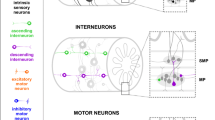Abstract
Nitrergic (NO) neurons play crucial inhibitory roles in the control of gut motility. Variations in the density of these neurons within the gastrointestinal tract (GI) may provide useful functional information, but, most surveys available have employed limited and/or highly localized samples. It remains unclear to what extent (a) NO neurons are concentrated disproportionately in particular GI regions, or (b) variations in NO cell number merely reflect changes in overall myenteric neuron density. This experiment surveyed the distributions of neuronal nitric oxide synthase-positive (NOS+) and other myenteric neurons in the GI tract, using immunohistochemical and Cuprolinic blue counterstaining techniques. Adjustable sampling grids superimposed on wholemounts were used to investigate the topographic patterns in the stomach (90 sampling sites; 45 per side) and proximal duodenum (63 loci). We present four major findings: First, variations were detected in the number of NOS+ neurons in specific regions of the stomach (e.g., corpus>antrum@forestomach) and along both longitudinal (oral>anal) and circumferential (mesenteric>antimesenteric) axes in the duodenum. Second, the variations in NOS+ neuronal counts within each organ covaried with the total number of myenteric neurons at different locations (stomach, r=0.77; duodenum, r=0.59), suggesting that local myenteric plexus density is a factor determining NOS+ cell concentrations. Third, in contrast to such a principle of covariation within each organ, NOS+ neurons constituted a consistently smaller proportion of gastric (20%) than of duodenal (28%) myenteric plexus neurons, suggesting that a second principle controls the characteristic percentages of the myenteric plexus that express NOS in different organs. Fourth, the regional samples were used to extrapolate the overall number of NOS+ and total myenteric cells in the rat stomach (43,000; 217,000) and first 3.5 cm of the small intestine (29,000; 103,000). These results, taken together, also suggest that the surveying protocol used is capable of detecting subtle differences in cellular distributions, thus providing a practical strategy for investigating patterns of chemical phenotypes within the GI tract.
Similar content being viewed by others
Author information
Authors and Affiliations
Additional information
Accepted: 7 August 1998
Rights and permissions
About this article
Cite this article
Jarvinen, M., Wollmann, W., Powrozek, T. et al. Nitric oxide synthase-containing neurons in the myenteric plexus of the rat gastrointestinal tract: distribution and regional density. Anat Embryol 199, 99–112 (1999). https://doi.org/10.1007/s004290050213
Issue Date:
DOI: https://doi.org/10.1007/s004290050213




